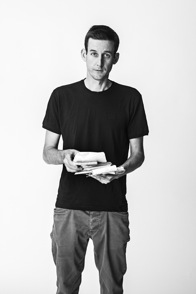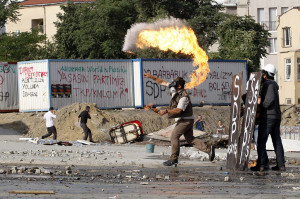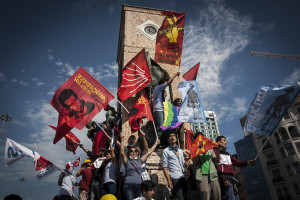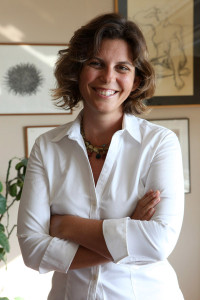 The Chicago Sun-Times’ decision to shut down its photography department to satisfy audiences “consistently seeking more video content with their news” is sad but not surprising. As an anthropologist who studies the changing culture of photojournalism and the rise of the visual content industry, the newspaper’s turn towards multimedia and video on the one hand and freelancers and text journalists equipped with iPhones on the other echoed the fears voiced to me by many in the last decade. The wording of the Sun-Times statement is telling: the news audience allegedly not only displays a preference for video but also does not perceive visuals as part of the news, rather they are reported to want “more video content with their news,” the way I might ask for fries with a burger.
The Chicago Sun-Times’ decision to shut down its photography department to satisfy audiences “consistently seeking more video content with their news” is sad but not surprising. As an anthropologist who studies the changing culture of photojournalism and the rise of the visual content industry, the newspaper’s turn towards multimedia and video on the one hand and freelancers and text journalists equipped with iPhones on the other echoed the fears voiced to me by many in the last decade. The wording of the Sun-Times statement is telling: the news audience allegedly not only displays a preference for video but also does not perceive visuals as part of the news, rather they are reported to want “more video content with their news,” the way I might ask for fries with a burger.
While photojournalism has given stark visibility to many topics, the labor behind producing and circulating news images has remained mostly invisible. Most narratives about photojournalism, including reports on this particular layoff, focus exclusively on photographers, whereas photographers are only part of a network of “image brokers” who make complex decisions about how to visualize the world. (Gürsel 2012a) Photo editors at publications and those working for wire services or agents for freelancers are just some of the other decision-makers involved in producing and distributing news images. Keeping the focus on the critical moment when a shutter is pressed effectively renders invisible all the other labor that goes into the production and circulation of a news image. Yet photojournalists as well as the relatively few scholars writing about photojournalism rarely discuss the research, logistics and complex decision-making that take place both before and after a photograph is “taken.”
With the labor behind news images reduced to a mere moment of button pressing, it is much easier to argue that the work can be performed readily by reporters equipped with iPhones. Even supporters of visual journalism focus on acknowledging the “craft” of professional photojournalists. Often what is lamented is a loss of aesthetic rather than journalistic excellence. Typical statements conclude that employers are not willing to pay for excellence in photography. Others bemoan that photographs will be less artfully framed or that those not trained in photography won’t know how to handle challenging lighting. All this is true but these arguments also obscure much of the labor behind insightful investigative visual journalism. A narrow focus on aesthetics makes it seem as if audiences are merely being offered less artfully shot video with their news.
Rather, news itself is being compromised and the political stakes are particularly high today. Governments, terrorists, corporations and militaries are increasingly conscious of how they are visualized and highly skilled at staging spectacles. These groups have themselves become image brokers. Perhaps there has never been a greater need for critical news images and journalists who can interrogate the world visually. Citizen journalists or amateur photographers can certainly document events, but relying on them exclusively risks having the news reduced to images of spectacles staged by interest groups. Investigative visual journalism requires thinking not just about how to photograph “an event” but critically interrogating how that event has been visually constituted and what lies behind it. An example:

Much of what I heard from the Turkish photographers paralleled former Chicago Sun- Times photographer John White’s 
The Chicago Sun-Times underscores its efforts to “evolve with our digitally savvy customers,” and much of the commentary written about the layoffs has framed this as a story of digital technologies killing off photojournalism. Yet it is important to look beyond a merely digital explanation. Opposition to photography at an American newspaper is nothing new. Communication scholar Barbie Zelizer gives a compelling historical account of how, from the beginning of widespread use of photography in news publications, photojournalism was seen as merely an “adjunct to word-journalism.” (Zelizer 1995: 87) Zelizer’s account emphasizes strong resistance to photography during the 1930s at a time when another technology – that enabling the wire transmission of photographs – made it possible for images to make up a significant portion of the content in dailies. Even if pictures were accepted as a commercial necessity for publications that were at the time competing with radio, many separated the photographer from the photographs, arguing that any reporter with a camera could produce news images.
I end by returning to the photograph taken by Brian Powers, among the youngest of the Chicago Sun-Times former staff photographers. Powers was commissioned by CNN to shoot a series of portraits of his former colleagues holding something meaningful from their careers. Stripped of their professional gear, which they were asked to return immediately, several posed with personal cameras that were particularly important to them – many given by family members and credited with sparking their interest in photography. Ryan Pagelow had worked at the paper for eleven years. According to Powers, Pagelow wanted to emphasize that having returned his camera, he did not have the basic tools to work as a freelancer.
“I have no equipment left. Just notebooks,” reads the caption. Of course, notebooks are a critical part of Pagelow’s equipment as a photojournalist. They may be significantly cheaper and decidedly more analog than his newspaper-owned camera, but these notebooks full of research, notes from conversations with photo editors, logistical information, names of subjects and quotes contain precisely the type of labor behind news images that is too often rendered invisible.
Works Cited
Gürsel, Zeynep Devrim (2013) Covering Gezi: Reflecting on Photographing Daily Life During Extraordinary Events. Jadaliyya, June 24, 2013.
Gürsel, Zeynep Devrim (2012) The Politics of Wire Service Photography: Infrastructures of Representation in a Digital Newsroom. American Ethnologist 39 (1).
Gürsel, Zeynep Devrim (2010) The Rule of Text: Everyday Practices of Editing the World. in The Anthropology of News and Journalism: Global Perspectives, Elizabeth Bird, ed. Indiana University Press, pp. 35-53.
Zelizer, B. (1995) Journalism's "last" stand: Wirephoto and the discourse of resistance. Journal of Communication, 45(2), 78-93.
Reach Further:
See the following for a discussion of rethinking photography as a mode of ethnography, specifically discussing the need to think about medium specificity.
“Photographic Figure Studies as a Mode of Ethnography?” Cultural Anthropology review essay for “Corpus: Mining the Border,” inaugural photo-essay by Danny Hoffman. http://production.culanth.org/photo_essays/1-corpus-mining-the-border
Zeynep Devrim Gürsel is an anthropologist and assistant professor in the department of International Studies a t Macalester College. She is currently completing a manuscript, Image Brokers, on the production, distribution, and circulation of international news images and the changing culture of photojournalism. She is also the director and co-producer of Coffee Futures (2009), the first in a series of short ethnographic films that explore contemporary Turkish politics through the prism of the everyday lives of women.
t Macalester College. She is currently completing a manuscript, Image Brokers, on the production, distribution, and circulation of international news images and the changing culture of photojournalism. She is also the director and co-producer of Coffee Futures (2009), the first in a series of short ethnographic films that explore contemporary Turkish politics through the prism of the everyday lives of women.

